We often hear about AI in big-picture terms – breakthrough technology, bold predictions, and futuristic potential. But how is it actually being used in everyday U.S. businesses?
To find out, Moneypenny surveyed 750 decision-makers across U.S. businesses between April and May 2025. The goal was simple: to understand how businesses are engaging with AI today, where it’s driving the most impact, and what stage they’re at in their adoption journey.
Here’s what the data reveals about where AI adoption stands today, where it’s headed next, and what it means for businesses like yours.
Are U.S. businesses currently using AI?
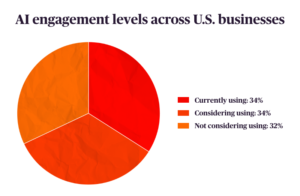
According to our data, 34. of U.S. businesses are already using AI in some form. A nearly identical 34.27% are actively considering it. Combined, that means over two-thirds of companies – 68% – are either actively using AI or planning to.
Only 32% of businesses say they’re not considering AI at all right now.
This even split between adopters, intenders, and holdouts paints a picture of a market still finding its feet. The appetite is clearly there – but many businesses are still working through practical questions around cost, value, and where AI fits. But as adoption grows, the focus is shifting from if businesses will use AI to how and where they’ll use it most effectively.
How are businesses adopting AI?
We asked businesses where they are on their AI journey, here’s what they said:
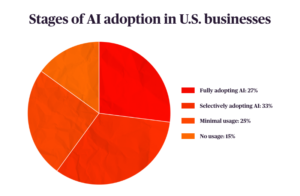
Just over a quarter (27%) said they’re fully embracing AI across their business. These are the early movers – typically with the resources, skills, or leadership in place to roll things out at scale.
But for most, the approach is more focused. 33% told us they’re adopting AI in specific areas, while continuing to explore where else it could add value.
Another 25% are still in the early stages – using AI in a limited way so far. And 15% said they have no plans to adopt it right now.
What this shows is that while some businesses are leading from the front, the majority are taking a measured, step-by-step approach. They’re applying AI where it makes the most sense, learning what works, and growing from there.
Rather than diving straight into full automation, most businesses are using AI to support their teams – not replace them. And in many cases, that’s proving to be the smartest route forward.
The top areas AI is being used by businesses today
AI might still feel like new territory – but U.S. businesses are already putting it to work in everyday ways. Here are the most common areas where it’s being used right now:
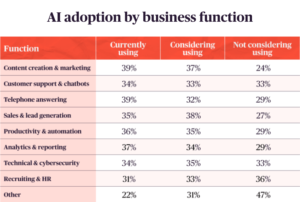
Leading the list is content creation and marketing, used by 39% of businesses. Right behind it is telephone answering at 39% – showing just how quickly AI is becoming part of customer-facing operations.
Functions like analytics and reporting (37%), productivity and automation tools (36%), and technical support and cybersecurity (34%) are also seeing a strong uptake. These are areas where AI helps teams work faster, smarter, and with fewer bottlenecks.
It’s worth noting how closely many of the top functions cluster together, with several sitting between 33% and 39% usage. That tells us businesses aren’t just testing AI in isolated spots – they’re applying it in multiple areas where it can deliver quick wins.
Telephone answering is one to watch. One in three businesses are already using AI to support call handling – and another third are actively considering it. In high-volume environments like professional services and Real Estate, that number could grow quickly.
Across the board, there’s a clear trend: the most effective AI use cases are the ones that support people – not replace them. Whether it’s helping teams respond faster, automate repetitive work, or create content at scale, AI is showing up as a teammate, not a takeover.
Company size matters – but it’s not everything
Larger businesses are, perhaps unsurprisingly, leading the way when it comes to AI. But the full picture is a little more nuanced. Here’s how adoption breaks down by company size:
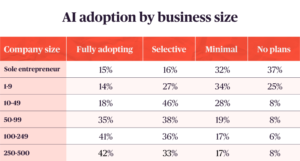
Among solo entrepreneurs, only 15% say they’ve fully embraced AI, while more than 37% aren’t even considering it yet. That means over half of the smallest businesses in the U.S. are still on the sidelines – often held back by limited time, lack of confidence, or simply juggling too many responsibilities at once.
Now compare that to businesses with 50–99 employees. Here, only 8% say they’re not planning to adopt AI, while over a third – 35% – are already fully using it across their organization. These businesses are in a sweet spot: big enough to have internal capacity, but still agile enough to move quickly when the right tools come along.
Large companies (250–500 employees) are setting the pace for full adoption, with 42% saying they’ve gone all in. With the budget, people, and structure to support innovation, they’re able to test, adapt, and integrate at scale.
It’s a useful reminder that while size can influence adoption, what really matters is access – to time, tools, budget, and confidence. As AI becomes more intuitive and more industry-specific, we expect the gap to shrink – especially in areas like marketing, automation, and reporting, where even small changes can deliver big returns.
Industry-by-industry: Who’s ahead of the curve?
When we combine the number of businesses fully embracing AI with those adopting it selectively, we get a clearer picture of which industries are leading the way – even if they haven’t rolled it out across every team just yet.
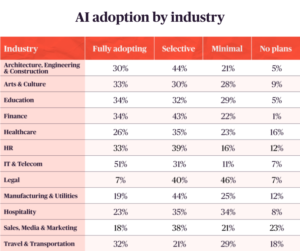
Tech & Telecom comes out on top, with more than over 80% of businesses either fully embracing (51%) or selectively using (31%) AI. That’s no surprise for a sector built on innovation—where teams are often well-positioned to test, integrate, and scale new tools quickly.
Finance (77%), HR (72%), and Architecture, Engineering & Construction (74%) also show strong engagement when it comes to fully or selectively embracing AI. These are industries where structure, data, and process are central – making them a natural fit for AI’s strengths in automation and insight.
Further down the list, industries like Healthcare (61%), Education (66%), and Arts & Culture (63%) are seeing more measured adoption. These are people-driven fields, so automation tends to roll out more cautiously – with trust and human impact front and center.
At the other end of the spectrum, Legal stands out with just 7% of businesses saying they’ve fully embraced AI. Nearly half (46%) are only using it minimally, and another 7% aren’t considering it at all. Whether it’s due to strict regulations, risk sensitivity, or the complexity of legal workflows, adoption here is clearly slower.
Sales, Media & Marketing and Travel & Transportation are also showing more hesitation, with higher levels of hesitation. In these industries, the path to AI adoption may be less straightforward – but the potential is still there, especially as AI tools become more tailored to customer experience and frontline operations.
What’s clear is that every industry is approaching AI in its own way. And as the tools continue to evolve, even the slower-moving sectors could see real momentum in the months ahead.
Which regions are embracing AI the most?
AI adoption isn’t just shaped by what your business does – but where it’s based, too.
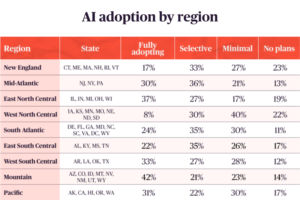
Our data shows some clear regional frontrunners. Businesses in the Mountain region are leading the way, with 42% fully embracing AI – the highest rate in the country. That might reflect a mix of growing innovation hubs, lower operating costs, and companies serving national markets from more flexible, tech-friendly locations.
East North Central states like Illinois, Ohio, and Michigan aren’t far behind, with 37% of businesses saying they’ve fully adopted AI. These are areas where manufacturing and logistics are prominent – and where AI is increasingly being leveraged to modernize and streamline traditional industries.
The Mid-Atlantic region (New York, New Jersey, Pennsylvania) is also above average, with nearly a third (30%) of businesses going all in, and another third (36%) using AI selectively.
At the other end of the spectrum, West North Central states – including Iowa, Nebraska, and the Dakotas – show just 8% full adoption. That region also reports the highest proportion of minimal usage and non-adoption combined, at over 60%. The reasons may include more traditional industry mixes and smaller average business sizes.
Elsewhere, areas like the South Atlantic and Pacific regions are taking a more cautious approach. Adoption here is more selective, with many businesses still in the exploration phase.
The key takeaway? AI adoption isn’t just about industry or company size – it’s also shaped by geography, local ecosystems, and access to knowledge. And for businesses in slower-adopting regions, that presents a major opportunity: to lead locally, even if the national curve is still catching up.
What it all means for U.S. businesses
Based on the trends we’re seeing, here’s what’s likely coming next:
1. From tools to strategy
Right now, most businesses are adopting AI one tool at a time. But we’re already seeing a shift – with more organizations building clear AI roadmaps, assigning internal leads, and setting specific goals.
2. AI that works for smaller businesses
As AI tools become more intuitive and tailored to industry-specific needs, small and mid-sized businesses will pick up speed. Expect to see more “plug and play” AI built for real world challenges – not just tech teams.
3. Human + AI working side-by-side
Businesses are learning that it’s not either/or. The best results come when AI supports people – not replaces them. That means chatbots with clear handovers, automation that frees up human time, and insights that help people do their jobs better.
4. Focus on trust, ethics and transparency
As AI becomes more visible to customers, trust will matter. Businesses will need to be clear about how they use AI – and make sure it reflects their values.
5. Upskilling and confidence-building
To unlock AI’s full value, your team needs more than access – they need confidence. We’re expecting to see more training, more knowledge-sharing, and more cross-team collaboration.
The key to success? Keep it simple. Start where you’ll see the biggest benefit. And never lose sight of the people behind your business – because that’s where your real value lies.
Looking beyond adoption
Over the coming weeks, Moneypenny will be sharing more findings from the survey, including what U.S. businesses really think about AI, the benefits they’re most excited by, the risks they’re concerned about, and who they trust to get it right.
We’ll break it all down clearly, so you have the insight you need to make smart, confident decisions about how AI fits into your business.
Interested in trying our AI Agent? See how our AI Beta Agent is already transforming client interactions. Discover more here.



















